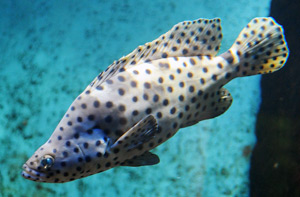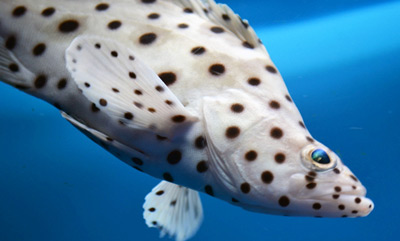Every time I need to make a point about marine fish that are sold as small, cute juveniles but grow into real behemoths, the panther grouper (Cromileptes altivelis according to Fishbase/Chromileptes altivelis according to ITIS) is one of several species that come to mind immediately. But despite its indisputable tankbusting tendencies, C. altivelis is very hardy, interesting, and well worth its sea salt if you have the space to spare.
Physical traits
Let’s get right to the panther grouper’s tankbusting size—which isn’t exaggerated, by the way. This Indo-Pacific species can grow to exceed 27 inches in total length. Even specimens that fall well short of that maximum are still fish to be reckoned with.
White to light brown in base coloration with black polka dots all over its body and fins, C. altivelis is an attractive species—and especially endearing as a juvenile. Adults often exhibit larger tan-colored patches in addition to the polka dots. The head of the fish is relatively small compared to its deep body, giving rise to another of this species’ common names—humpback grouper (other common epithets include barramundi cod and polka dot grouper).
Feeding

C. altivelis is all predator, feeding on small fish and crustaceans. Captive specimens are not picky eaters and will accept just about any meaty foods offered. Items along the lines of chopped fish, whole silversides, shrimp, clams, and mussels are all good choices. Some specimens may learn to accept pellet foods (such as New Life Spectrum Large Fish Formula) as well, but you can’t depend on it. Feed only twice a week to every other day.
Housing
This grouper needs both ample swimming space for cruising as well as an abundance of rockwork caves and ledges to hide in/under. That should tip you off that a really big tank is in order. I wouldn’t go any smaller than 200 gallons. Also, the panther grouper is a messy eater and copious waste producer, so efficient filtration, oversized protein skimming, and frequent water changes are a must.
Compatibility
C. altivelis isn’t particularly aggressive, but it will eat any fish or crustacean small enough to fit in its mouth. This is the most important consideration with respect to choosing tankmates. Otherwise, it will tend to leave most other fish alone. Though the panther grouper won’t directly harm sessile invertebrates, it’s not an ideal candidate for reef systems owing to its prodigious maximum size and the high level of dissolved pollutants it’s apt to generate.



